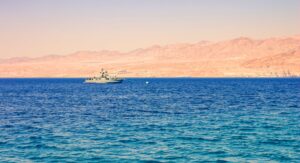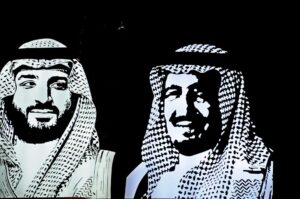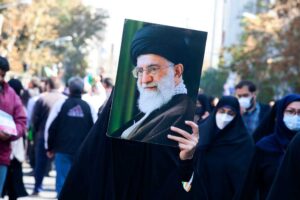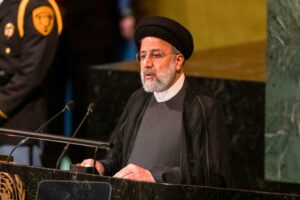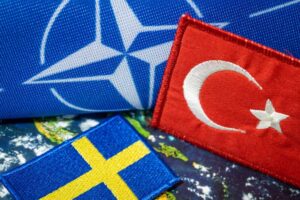Benjamin Netanyahu, Israel’s former Prime Minister, who is once again running for that office, made a career selling a catching idea. Instead of the unappealing and risky formula of “land for peace,” he promoted “peace for peace.”[i]
For decades, this suggestion was ridiculed as either totally unrealistic or just a political ploy. But the dawn of the ‘Abraham Accords’ upended the public discourse and surprised many in the policy community. Here they were, the United Arab Emirates, Bahrain, Morocco and Sudan, signing ‘peace accords’ which involved no land concessions from Israel—quod erat demonstrandum. For most Israelis, the wider and deeper context, including the Trump administration plan that specifically called for the gradual creation of a Palestinian state, the relinquished U.S. annexation ‘license’ for parts of the West Bank, as well as the arms and surveillance equipment deals that were all part and parcel of the agreements, were completely lost in translation. Netanyahu took care of that by using his almost total control of Israeli media and faced virtually zero political opposition. After all, which Israeli-Jewish political actor can say ‘no’ to cost-free peace in the Middle East?
Israeli culture is a strange mix of lightspeed adaptation to certain changes and deeply entrenched dogmas that are unbreakable even as they fly in the face of clear realities. In the case of the Abraham Accords, the ink on the papers hadn’t dried when the first batch of energised Israeli tourists landed in Dubai, cash in hand, ready to absorb it all up. Tens if not hundreds of thousands of such tourists continue to flock to the Emirates, the new ‘it’ place to visit. And it doesn’t stop there.
The business community, leading Mizrahi (Jewish-Arab) musicians and multiple government ministers are flooding the Emirates with high-profile visits, joint venture ideas and an endless appetite for all things Emirati. The overall effect is significant, slowly reclassifying the image of ‘Arabs’ in Israeli popular culture. Israelis now distinguish between local Arabs, i.e., Palestinians residing in the territories or in Israel-proper, and the “new Arabs”, those from the newly-opened land of Gulf dreams, who are the subject of courting and genuine interest. A small anecdote that illustrates the point came in the shape of three young Palestinians who decided to dress up like Emiratis, long white dishdashas and all, and pose as tourists walking in the streets of Tel Aviv. The warm and excited reactions they received from passers-by were a complete contrast to what they are used to as local Palestinians.[ii]
These strong popular sentiments have shaped politicians’ stances. Among all parties, the only objections came from the fringe, nationalist United Arab Party, which protested the proverbial—almost physical, in fact—throwing of the Palestinian issue under the wheels of the jets taking off from Tel Aviv for Abu Dhabi. The rest quickly aligned with the government and hailed the accords as a historic breakthrough.
Beyond the Emirates—the ‘main course’—and Bahrain—a Gulf side dish—another jewel in the Abraham Accords crown was Morocco, the actual or cultural homeland of more than half a million Israelis, including a significant number of Members of Knesset. For them especially, the possibility to visit the country and celebrate their collective identity is of enormous consequence.
It is not the first time in Israel’s history that the closed gates of the Middle East have suddenly been cracked open. In the mid-1990s, the era of the Oslo Accords, a similar wave of optimism, curiosity and goodwill swept through Israel. This however, was short-lived and came to a horrific end with Prime Minister Yizhak Rabin’s assassination, the breaking down of the peace process and the eruption of the Second Intifada. The collective trauma of thousands of Israelis killed or injured in suicide bombings shattered all hopes for peace for decades, and the Israelis reconciled themselves to the new-old realities of perpetual regional hostility.
The Abraham Accords brought a new and far less risky version of that domestic and regional dynamic. And this time the Palestinians do not get to celebrate on their rooftops and chant that ‘Millions of shahids (martyrs) are marching to Jerusalem’ as some of them did after successful suicide attacks. Nowadays, it is the degree of their marginalisation and collective humiliation by their Arab brothers that concerns them. Gone are the days of regional solidarity with their cause. Each Arab regime is now invested in pursuing its own interests, and the barriers to dealing with Israel have been lowered to a minimum.
Thus, on the surface at least, Netanyahu’s old and steady strategy of cutting peace deals over the heads of the Palestinians appears to have persevered. Many influential figures in Israel genuinely support this. Others point out the obvious flaws that are inconsistent with that view. But as Israel gears up towards its fifth round of general elections within three years—a world record, surpassing the Weimar Republic—its entire political system has veered to the Right. The new consensus revolves around the Abraham Accords, which some politicians are marketing as a first step towards a ‘Middle Eastern NATO against Iran and its allies.’ The Israeli-Palestinian conflict is merely treated as a thorn in the side of wider scale processes of normalization, a nuisance that a smart, consistent military and intelligence effort can handle, without significant collateral damage to Israel’s strategic interests.
The long and ultimately inevitable demise of Mahmoud Abbas as President of the Palestinian Authority only serves to highlight that. The separation between the West Bank and Gaza, which in 2006 seemed like an anomaly, is now the new normal. And the overall trend of Israel gaining military and economic strength, and the Palestinians weakening and sinking to new political and national lows seem destined to continue. With the US reorienting its global strategy away from the Middle East, and the Europeans suddenly dealing with a war on their doorsteps, it seems that no external power, global or regional, will intervene on the Palestinian’s behalf.
The black horse in that historical race, however, is demographic concerns. According to expert surveys[iii], within the overall population between the Mediterranean Sea and the Jordan River, there is already a Palestinian-Arab majority of just over 50 per cent. The Arab population is governed by different structures depending on where between the Mediterranean Sea and the Jordan River they reside. A liberal democracy for those of the 1.9 million Israeli Arabs living among nearly 7 million Israeli Jews[iv]; a democracy in name only for the 3.2 million West Bank Palestinians under the rule of the Palestinian Authority, which had not held elections since 2006, and totalitarian Hamas-controlled rule for the more than 2.1 million Gazans.[v] How long will that kind of geopolitical fragmentation hold? At what point will some or many of the disenfranchised Palestinians revolt? And what might be the consequences of such a revolt?
For the Israeli extreme Right, such an uprising is seen as an opportunity for ‘a second Nakba,’ exiling much of the Palestinian population unto Jordan. For others on the Israeli Right, it opens the door for the forced annexation of the West Bank, which will be presented as a ‘defensive necessity.’ For the centrists and leftists, it is an alarming wake-up call for ‘separation’ from parts of the West Bank, based on the already existing wall. But all of them are not seriously engaging in that debate. They prefer to go with the flow, board the next flight to Dubai or Marrakesh, celebrate the ‘new Middle East’ and fortify their political strongholds. Never underestimate the power of denial.
[i] Levine, Cody. “Netanyahu: ‘Land for Peace’ formula ineffective for Middle East peace.” Jerusalem Post. 16 August 2020. https://www.jpost.com/israel-news/netanyahu-land-for-peace-formula-ineffective-for-middle-east-peace-638860.
[ii] Ayoubi, Nur. “‘Trolling to another level’: Palestinians pose as Emiratis in Tel Aviv.” Middle East Eye. 7 December 2020. https://www.middleeasteye.net/news/israel-palestine-uae-pose-emirati-viral-video.
[iii] “Israel’s demography at the beginning of a new decade: national implications,” INSS, July 2021. https://strategicassessment.inss.org.il/articles/even/.
[iv] “Population of Israel on the Eve of 2021.” Israel Bureau of Statistics. 31 December 2020. https://www.pcbs.gov.ps/site/lang__en/881/default.aspx#Population.
[v] Palestinian data according to the Palestinian Bureau of Statistics via https://www.pcbs.gov.ps/site/lang__en/881/default.aspx#Population.






